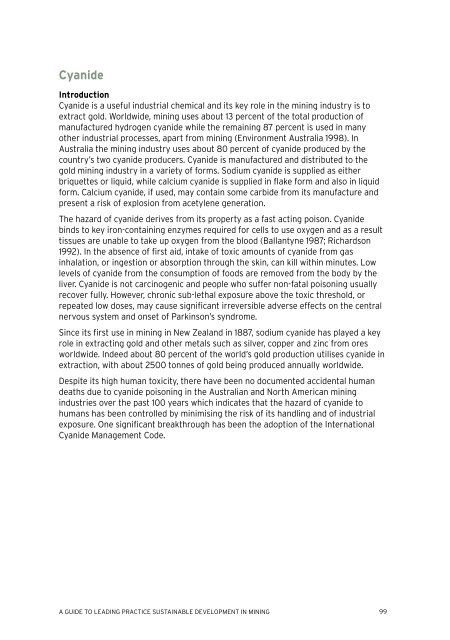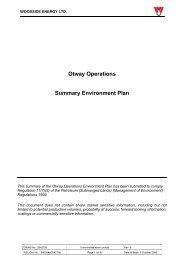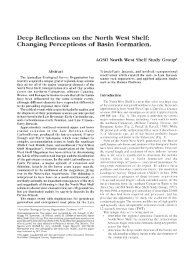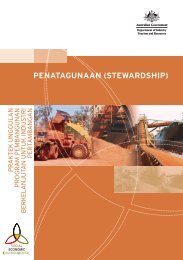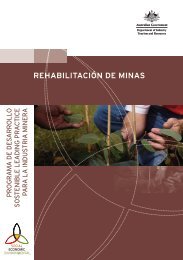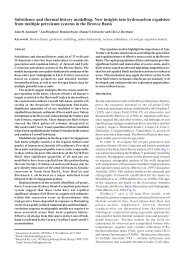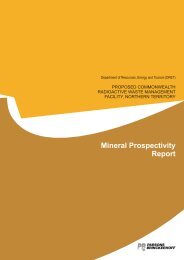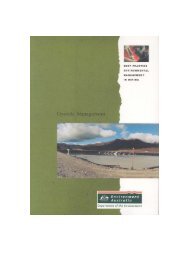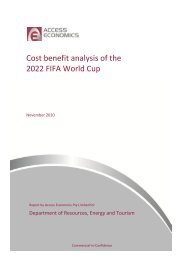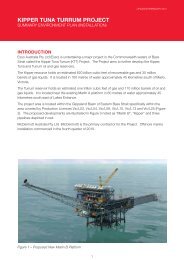A guide to leading practice sustainable development in mining
A guide to leading practice sustainable development in mining
A guide to leading practice sustainable development in mining
Create successful ePaper yourself
Turn your PDF publications into a flip-book with our unique Google optimized e-Paper software.
Cyanide<br />
Introduction<br />
Cyanide is a useful <strong>in</strong>dustrial chemical and its key role <strong>in</strong> the m<strong>in</strong><strong>in</strong>g <strong>in</strong>dustry is <strong>to</strong><br />
extract gold. Worldwide, m<strong>in</strong><strong>in</strong>g uses about 13 percent of the <strong>to</strong>tal production of<br />
manufactured hydrogen cyanide while the rema<strong>in</strong><strong>in</strong>g 87 percent is used <strong>in</strong> many<br />
other <strong>in</strong>dustrial processes, apart from m<strong>in</strong><strong>in</strong>g (Environment Australia 1998). In<br />
Australia the m<strong>in</strong><strong>in</strong>g <strong>in</strong>dustry uses about 80 percent of cyanide produced by the<br />
country’s two cyanide producers. Cyanide is manufactured and distributed <strong>to</strong> the<br />
gold m<strong>in</strong><strong>in</strong>g <strong>in</strong>dustry <strong>in</strong> a variety of forms. Sodium cyanide is supplied as either<br />
briquettes or liquid, while calcium cyanide is supplied <strong>in</strong> flake form and also <strong>in</strong> liquid<br />
form. Calcium cyanide, if used, may conta<strong>in</strong> some carbide from its manufacture and<br />
present a risk of explosion from acetylene generation.<br />
The hazard of cyanide derives from its property as a fast act<strong>in</strong>g poison. Cyanide<br />
b<strong>in</strong>ds <strong>to</strong> key iron-conta<strong>in</strong><strong>in</strong>g enzymes required for cells <strong>to</strong> use oxygen and as a result<br />
tissues are unable <strong>to</strong> take up oxygen from the blood (Ballantyne 1987; Richardson<br />
1992). In the absence of first aid, <strong>in</strong>take of <strong>to</strong>xic amounts of cyanide from gas<br />
<strong>in</strong>halation, or <strong>in</strong>gestion or absorption through the sk<strong>in</strong>, can kill with<strong>in</strong> m<strong>in</strong>utes. Low<br />
levels of cyanide from the consumption of foods are removed from the body by the<br />
liver. Cyanide is not carc<strong>in</strong>ogenic and people who suffer non-fatal poison<strong>in</strong>g usually<br />
recover fully. However, chronic sub-lethal exposure above the <strong>to</strong>xic threshold, or<br />
repeated low doses, may cause significant irreversible adverse effects on the central<br />
nervous system and onset of Park<strong>in</strong>son’s syndrome.<br />
S<strong>in</strong>ce its first use <strong>in</strong> m<strong>in</strong><strong>in</strong>g <strong>in</strong> New Zealand <strong>in</strong> 1887, sodium cyanide has played a key<br />
role <strong>in</strong> extract<strong>in</strong>g gold and other metals such as silver, copper and z<strong>in</strong>c from ores<br />
worldwide. Indeed about 80 percent of the world’s gold production utilises cyanide <strong>in</strong><br />
extraction, with about 2500 <strong>to</strong>nnes of gold be<strong>in</strong>g produced annually worldwide.<br />
Despite its high human <strong>to</strong>xicity, there have been no documented accidental human<br />
deaths due <strong>to</strong> cyanide poison<strong>in</strong>g <strong>in</strong> the Australian and North American m<strong>in</strong><strong>in</strong>g<br />
<strong>in</strong>dustries over the past 100 years which <strong>in</strong>dicates that the hazard of cyanide <strong>to</strong><br />
humans has been controlled by m<strong>in</strong>imis<strong>in</strong>g the risk of its handl<strong>in</strong>g and of <strong>in</strong>dustrial<br />
exposure. One significant breakthrough has been the adoption of the International<br />
Cyanide Management Code.<br />
A GUIDE TO LEADING PRACTICE SUSTAINABLE DEVELOPMENT IN MINING 99


